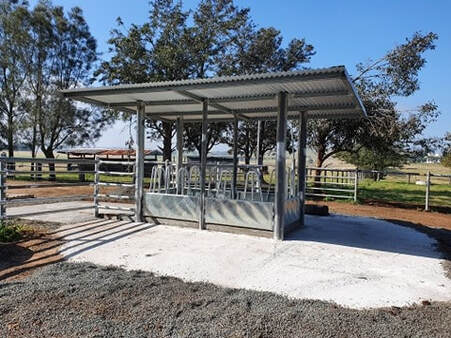|
When we first released information on our fenceline feeders, we never thought producers from all over the country would be interested in what a farm in Kentucky was doing. What we found most interesting was the amount of interested producers from other countries including Canada, England, Switzerland, and Australia. Back in July, Karinne Gelderman, a cattle producer in Australia, sent us pictures of the fenceline feeder she implemented on her farm. Much like in the US, the beef cattle industry plays a large part in Australia's agriculture and overall economy. Australia is home to 26.4 million head of cattle, with 41,800 agricultural businesses involved in the cattle industry. They produce 3% of the world's beef supply and are the third largest beef exporter in the world. More than 77% of the total agricultural land in Australia is managed by farms with beef cattle, and around 50% of all Australian farms have beef cattle. Karinne was gracious enough to share some more information on her design and how she adapted the design and materials of the fenceline feeder to better fit her farm. Name: Karinne Gelderman (Berdihold Limousin Stud) Location: Hunter Valley, NSW, Australia Herd Size: 40 breeders Class of Cattle: Stud cattle (Limousins) Q. How did you first hear about Eden Shale Farm? A. Online on Facebook Q. What project did you implement on your farm? A. Fenceline feeder Q. Is this the first project you have implemented from Eden Shale Farm? A. Yes Q. Is there anything you changed when implementing this practice? (i.e., layout, design, size, any additions, etc.) A. Changes were made due to not having the same sort of location (top of a hill / slope). We have done landscaping and also sloped the concrete to allow water to run off. We have had quite a bit of rain and it is working well. We also cannot purchase the pre-fabricated panels in Australia that you used so we made our own. Due to COVID it was going to take too long to import anything. We decided to make all of the panels the same to made it easier to manufacture. The panels are quick and easy to remove in case something manages to get inside the feeder. Each panel is flat & is 1.4m x 1.1m (4.6ft x 3.6ft) tall including the bows. The bows are made of 32mm round bar x 3mm thick walls. The rectangular frame is 500mm high and is made of 50mm square tube. The sheet metal covering the rectangular frame is 2mm thick. Each panel was hot dipped galvanized. The concrete pad is at least 3m wider than the feeder at all points for them to stand on and it is stamped so that they don't slip. The pad for the bale is 100mm (about 4 in.) higher than the pad that the cattle stand on. The total cost was less than $6000 including the concrete which was $1,500. Q. If you have used this practice, what do you like most? What would you change? A. It has been used for a few months now and the feeder itself is working really well. We had put gravel where the concrete pad meets the paddock and that gravel has worn away a bit. I think this is more because we started using the feeder as soon as it was installed and didn't compact it enough. When the paddock dries up a bit more, we will put more gravel down and compact it better. Q. What would you recommend for other producers that wish to implement this practice? A. The fenceline feeder has saved so much time and I'm not getting bogged everyday in the paddocks. I'd recommend that other people set theirs up before next winter! I'd probably tell others to know what sized bales they normally use before manufacture. We commonly feed 8x4x3 bales but on rare occasions use 8x4x4 so we made sure that the bales could easily fit in the feeder. Q. Would you recommend Eden Shale Farm resources to others? A. Yes, the Eden Shale Facebook page & the newsletters are really interesting and make you think of better ways to do things. Comments are closed.
|
Archives
June 2024
Categories
All
Welcome |
CONTACT US |
EMAIL SIGN UP |
|
Eden Shale Farm
245 Eden Shale Rd. Office: (859) 278-0899 Owenton, KY 40359 Fax: (859) 260-2060 © 2021 Kentucky Beef Network, LLC.. All rights reserved.
|
Receive our blog updates
|







 RSS Feed
RSS Feed
